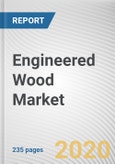The engineered wood market is mainly driven by rise in renovation and remodeling of older homes. Moreover, new housing projects are also responsible to drive the engineered wood market. In addition, as engineered wood is cost effective and eco-friendly alternative to other wood and cement products increase in use of engineered wood as substitution for building materials. Moreover, engineered wood emits lesser harmful bi-products while manufacturing compared to emission-intensive materials, such as concrete, steel, or aluminum. Therefore engineered wood is expected to minimize greenhouse gas emissions. In addition, adhesives/resins used in engineered wood are stable environmentally and do not produce greenhouse gases. This has led to increase in use of engineered wood among builders and architects. However, cheaper material such as plastic laminates and foils, re-sanded and re-used engineered wood products and panels act as restraint to the market. However, urbanization of developing countries in Asia-Pacific and LAMEA is expected to boost the engineered wood market during the forecast period.
The engineered wood market is segmented into type, application, end user, and region. On the basis of type, the market is divided into I-Beams, plywood, laminated veneer lumber (LVL), glulam (glued laminated timber), oriented strand boards (OSB), cross-laminated timber (CLT), and others. Depending on application, it is classified into construction, furniture, flooring, packaging and others. By end user, it is segregated into residential and commercial & industrial. By region, it is analyzed across North America (the U.S., Canada, and Mexico), Europe (Germany, the UK, France, Italy and rest of Europe), Asia-Pacific (China, Japan, South Korea, India, and Rest of Asia-Pacific), and LAMEA (Latin America, Middle East, and Africa).
COMPETITION ANALYSIS
The major players profiled in the engineered wood market include Boise Cascade Company, Celulosa Arauco y Constitucion SA, Huber Engineered Woods LLC, Louisiana-Pacific Corporation (LP), Norbord Inc., Patrick Industries, Inc., Raute Group, Shenzhen Risewell Industry Co., Ltd, Universal Forest Products, Inc. and Weyerhaeuser Company. Major companies in the market have adopted strategies such as business expansion, agreement, acquisition and product launch to offer better services to customers in the engineered wood market.
KEY BENEFITS FOR STAKEHOLDERS
- The report provides an extensive analysis of the current and emerging engineered wood market trends and dynamics.
- In-depth engineered wood market analysis is conducted by estimations for the key segments between 2020 and 2027.
- Extensive analysis of the market is conducted by following key product positioning and monitoring of top competitors within the market framework.
- A comprehensive analysis of four major regions is provided to determine the prevailing opportunities.
- The market forecast analysis from 2020 to 2027 is included in the report.
- The key market players operating in the market are profiled in this report and their strategies are analyzed thoroughly, which help understand the competitive outlook of the market industry.
KEY MARKET SEGMENTS
By Type
- I-Beams
- Plywood
- Laminated Veneer Lumber (LVL)
- Glulam (Glued Laminated Timber)
- Oriented Strand Boards (OSB)
- Cross-Laminated Timber (CLT)
- Others
By Application
- Construction
- Furniture
- Flooring
- Packaging
- Others
By End-User
- Residential
- Commercial & Industrial
By Region
- North America
- U.S.
- Canada
- Mexico
- Europe
- Germany
- UK
- France
- Italy
- Rest of Europe
- Asia-Pacific
- China
- Japan
- South Korea
- India
- Rest of Asia-Pacific
- LAMEA
- Latin America
- Middle East
- Africa
KEY PLAYERS
- Boise Cascade Company
- Celulosa Arauco Y Constitucion SA
- Huber Engineered Woods LLC
- Louisiana-Pacific Corporation (LP)
- Norbord Inc.
- Patrick Industries, Inc.
- Raute Group
- Shenzhen Risewell Industry Co., Ltd
- Universal Forest Products, Inc.
- Weyerhaeuser Company
Table of Contents
Methodology
The analyst offers exhaustive research and analysis based on a wide variety of factual inputs, which largely include interviews with industry participants, reliable statistics, and regional intelligence. The in-house industry experts play an instrumental role in designing analytic tools and models, tailored to the requirements of a particular industry segment. The primary research efforts include reaching out participants through mail, tele-conversations, referrals, professional networks, and face-to-face interactions.
They are also in professional corporate relations with various companies that allow them greater flexibility for reaching out to industry participants and commentators for interviews and discussions.
They also refer to a broad array of industry sources for their secondary research, which typically include; however, not limited to:
- Company SEC filings, annual reports, company websites, broker & financial reports, and investor presentations for competitive scenario and shape of the industry
- Scientific and technical writings for product information and related preemptions
- Regional government and statistical databases for macro analysis
- Authentic news articles and other related releases for market evaluation
- Internal and external proprietary databases, key market indicators, and relevant press releases for market estimates and forecast
Furthermore, the accuracy of the data will be analyzed and validated by conducting additional primaries with various industry experts and KOLs. They also provide robust post-sales support to clients.

LOADING...









